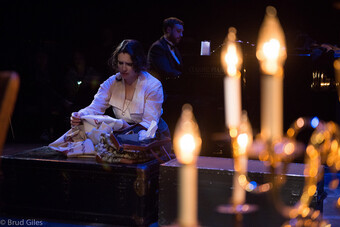Why We Do Theater in Trucks
In 2010, we began a theater company called The Truck Project, which creates original works presented inside twenty-four foot rented box trucks. For us, the novel choice of venue has never been merely a gimmick. Nor is it a compromise we make out of financial necessity. It is part of an overall approach to theater making that we find exciting for the freedom it affords us as artists as well as producers.
To answer a few FAQs off the bat: Yes, the audience is inside the truck with us during the show. We seat up to sixteen people at a time. And no, the truck is never in motion during the show. That would be crazy. Because there is no established protocol for doing or seeing theater in a truck, we are met with questions constantly. This is the first great advantage.
People begin to interact with art when it requires them to move outside their filter of preconceptions. When people ask us about the mechanics of truck-as-theater-venue, what they’re really asking is: How alien is this experience to me? Is it dangerous? Is it slapdash? Is this an experience I can trust? They are reconfiguring their expectations, and we are careful not to fill in all the blanks. It’s not going too far to say that the simple act of declaring a rented truck to be a theater venue is a creative act in itself.
We like to say that an audience member’s experience of the show begins before he or she buys a ticket. The Truck Project is a larger experience that contains a theatrical performance. The artwork begins when our audience first hears about us, continues through the emails we send after they purchase a ticket, is heightened by following instructions on how to meet up for the show, and extends through the post-show cocktails we invite our audience to share with us. Presenting in a truck venue necessitates that we embrace the outside world (where would we be without bars and their restrooms?), so we find ways to frame the outside world in the terms of our performance.
This blurs the lines of what is and is not part of the show, giving audiences a theatrically heightened experience of everything around them. One night during our last run, a journalist in attendance decided to interview audience members during intermission—and no one could be sure if he was a real journalist or a performer. Every night, some random occurrence will cause an audience member to half-jokingly ask, “Is this part of the show?” Whether or not we planned it, the answer is of course, “yes.”
Rainy nights are invariably the most exciting for our audiences because of the added sense of adventure in finding the truck, and the added sense of intimacy once inside. The fact that we cannot shut out ambient noise, which we once considered a liability, has in practice become an asset. There is something satisfyingly secretive about being separated from the outside world while still being aware of its presence all around you.
The challenge of creating theater that interacts with the space in a compelling way is the second great advantage of our chosen venue. To answer a question we are never asked: We will probably never do a play in a truck about two people moving apartments. We prefer to explore a theatrical space that exists somewhere between reality and agreed upon fantasy. The truck is always a truck, but it always takes on an added dimension as well. It has been a vaudeville theater, a private home, a seminar room, a fishbowl, and so on. Conjuring these other worlds requires the active imagination of our audience. They are making an imaginative leap in a space not built for these worlds, making them constantly aware of the creative act they are involved in. That’s the form of audience participation that fuels this project.
Another appealing aspect of this work is the freedom it affords us as producers and presenters. We can rent our venue anytime, anywhere across the country. Though we are based in Brooklyn, we—as relatively unknown theater artists—have been able to orchestrate a tour that put our work in front of audiences in cities across the United States. The venue can be opened at any hour and located wherever parking is available.
It is also a much more economically sustainable model than most conventional theater. Even with the small house size we have been able to cover costs, and even turn a profit, on ticket sales alone. All while maintaining affordable ticket prices.
There is much that can be done in a truck that cannot be done in a conventional theater—and vice versa. To answer one last FAQ: Yes, we do also work indoors. The shows we create for a truck will forever only be performed in a truck, as they’d be much different shows if we wrote them with a brick and mortar theater in mind. But working in trucks is a great primer in how to exploit the particulars of a given environment, and a great reminder that we shouldn’t take theater spaces and the assumptions that come with them for granted. Conventions are great, but using them should be a choice.
***
The Truck Project is a co-creation of theater artists Jean Ann Douglass and Eric John Meyer. The Project premiered in 2010 with a double bill of solo performances The Backroad Homeshow and Not Winehouse, which played in Brooklyn, New York, Spartanburg, South Carolina, New Orleans, Louisiana, and Austin, Texas. The Truck Project’s new double bill of short plays FISH and OBFUSCATION are currently running somewhere in Brooklyn.








Comments
The article is just the start of the conversation—we want to know what you think about this subject, too! HowlRound is a space for knowledge-sharing, and we welcome spirited, thoughtful, and on-topic dialogue. Find our full comments policy here